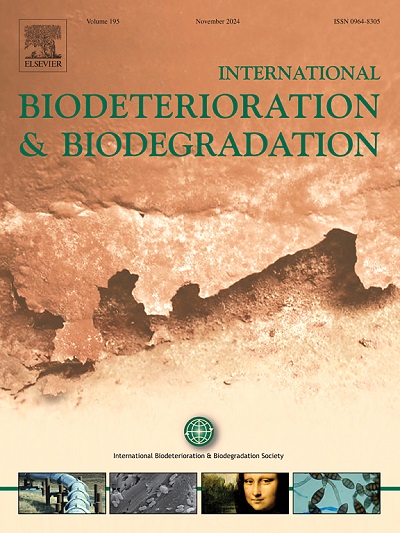The dissipation of Di (2-ethylhexyl) phthalate in soil with different moisture: A comprehensive analysis of its relationship with microbial community structure
IF 4.1
2区 环境科学与生态学
Q2 BIOTECHNOLOGY & APPLIED MICROBIOLOGY
International Biodeterioration & Biodegradation
Pub Date : 2025-04-27
DOI:10.1016/j.ibiod.2025.106107
引用次数: 0
Abstract
Phthalate esters (PAEs) have become an increasing pollutant in agricultural soils, and soil moisture plays a crucial role in influencing the dissipation of PAEs in soil. Di (2-ethylhexyl) phthalate (DEHP) was selected as a representative of PAEs in the soil microcosm experiment to investigate the effects of soil moisture on the dissipation of PAEs. Soil microorganisms were analyzed by phospholipid fatty acids (PLFAs) and DNA-based (bacteria 16S rRNA gene and fungi ITS gene) high-throughput sequencing to reveal the relationships between microbial communities and PAEs dissipation. The results showed that 60 % water-holding capacity (WHC) was an appropriate moisture for DEHP dissipation. According to the PLFAs analysis, DEHP significantly increased the total microorganism biomass and the growth of actinomycetes, and it significantly decreased the H value and the growth of gram (−) bacteria. Significant correlations were found between soil moisture and the biomass of fungi, gram (−) bacteria, gram (+) bacteria, anaerobe, and actinomycetes. The fungal biomass was higher in the soils with 60 % WHC than those in the soils with 100 % WHC. The relative abundance of DEHP-degrading bacteria (Sphingoaurantiacus, Sphingomonas, Lysobacter, and Arthrobacter) and DEHP-degrading fungi (Fusarium) were higher in the soils with 60 % WHC than those in the soils with 100 % WHC, based on DNA-based high-throughput sequencing analysis. Meanwhile, significant positive correlations were observed between the dissipation of DEHP and the abundance of degrading microorganisms. DEHP significantly decreased the bacterial diversity but increased the richness of bacteria and actinomycetes, as well as the relative abundance of DEHP-degrading bacteria (Proteobacteria, Sphingomonas, Gemmatimonas, and Ramlibacter) and fungi (Fusarium and Talaromyces).

邻苯二甲酸二(2-乙基己基)在不同湿度土壤中的耗散:与微生物群落结构关系的综合分析
邻苯二甲酸酯(PAEs)已成为农业土壤中日益严重的污染物,土壤湿度对其在土壤中的消散起着至关重要的作用。选取邻苯二甲酸二(2-乙基己基)酯(DEHP)作为PAEs的代表进行土壤微观环境试验,探讨土壤水分对PAEs耗散的影响。采用磷脂脂肪酸(PLFAs)和基于dna(细菌16S rRNA基因和真菌ITS基因)的高通量测序分析土壤微生物,揭示微生物群落与PAEs耗散的关系。结果表明,60%的持水量(WHC)是DEHP耗散的适宜水分。PLFAs分析显示,DEHP显著提高了微生物总生物量和放线菌的生长,显著降低了H值和革兰氏(−)菌的生长。土壤湿度与真菌、革兰氏(−)菌、革兰氏(+)菌、厌氧菌和放线菌的生物量呈显著相关。60% WHC的土壤真菌生物量高于100% WHC的土壤。基于dna的高通量测序分析表明,60% WHC的土壤中dehp降解细菌(Sphingoaurantiacus、Sphingomonas、Lysobacter和Arthrobacter)和真菌(Fusarium)的相对丰度高于100% WHC的土壤。同时,DEHP耗散与降解微生物丰度呈显著正相关。DEHP显著降低了细菌多样性,但增加了细菌和放线菌的丰富度,以及DEHP降解细菌(Proteobacteria、Sphingomonas、Gemmatimonas和Ramlibacter)和真菌(Fusarium和Talaromyces)的相对丰富度。
本文章由计算机程序翻译,如有差异,请以英文原文为准。
求助全文
约1分钟内获得全文
求助全文
来源期刊
CiteScore
9.60
自引率
10.40%
发文量
107
审稿时长
21 days
期刊介绍:
International Biodeterioration and Biodegradation publishes original research papers and reviews on the biological causes of deterioration or degradation.

 求助内容:
求助内容: 应助结果提醒方式:
应助结果提醒方式:


